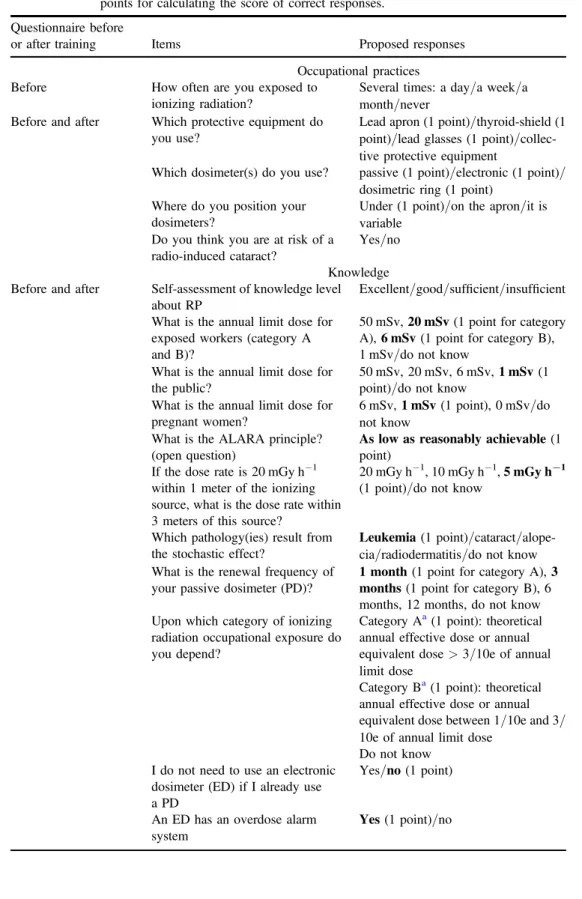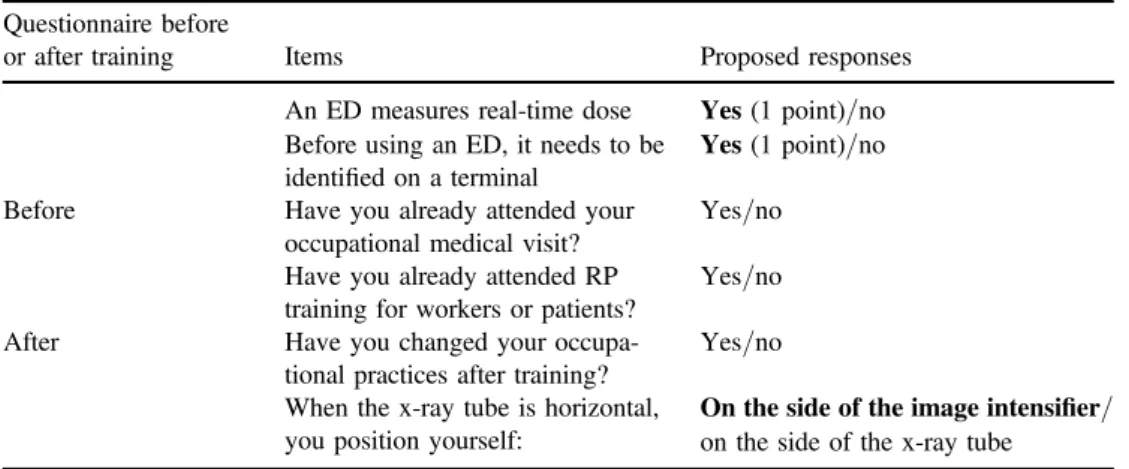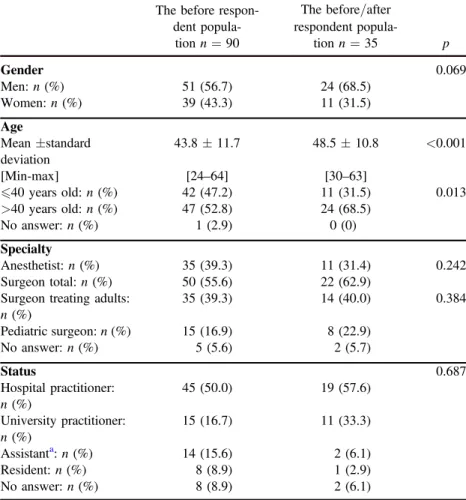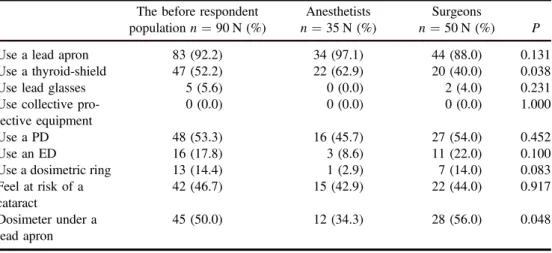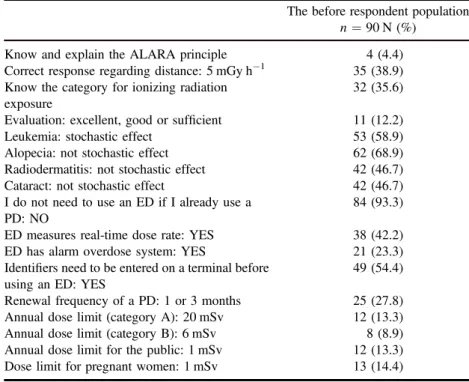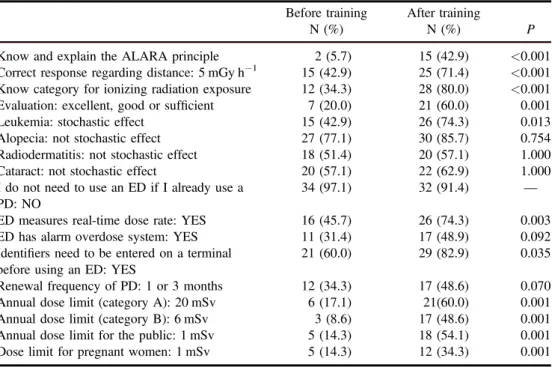HAL Id: hal-02058180
https://hal-amu.archives-ouvertes.fr/hal-02058180
Submitted on 10 Apr 2019
HAL is a multi-disciplinary open access
archive for the deposit and dissemination of
sci-entific research documents, whether they are
pub-lished or not. The documents may come from
teaching and research institutions in France or
L’archive ouverte pluridisciplinaire HAL, est
destinée au dépôt et à la diffusion de documents
scientifiques de niveau recherche, publiés ou non,
émanant des établissements d’enseignement et de
recherche français ou étrangers, des laboratoires
Radiation protection for surgeons and anesthetists:
practices and knowledge before and after training
Amandine Brun, A Alcaraz Mor, M. Bourrelly, G Dalivoust, G Gazazian, R
Boufercha, M Lehucher-Michel, M Sari-Minodier
To cite this version:
Amandine Brun, A Alcaraz Mor, M. Bourrelly, G Dalivoust, G Gazazian, et al.. Radiation
pro-tection for surgeons and anesthetists: practices and knowledge before and after training. Journal
of Radiological Protection, IOP Publishing, 2018, 38 (1), pp.175-188. �10.1088/1361-6498/aa9dbd�.
�hal-02058180�
Radiation protection for surgeons and
anesthetists: practices and knowledge
before and after training
A Brun
1, R Alcaraz Mor
1,2, M Bourrelly
3, G Dalivoust
1,
G Gazazian
1, R Boufercha
1, M P Lehucher-Michel
1,2and
I Sari-Minodier
1,41
APHM, La Timone Hospital, Occupational Medicine and Health Department, F-13385 Marseille, France
2
Aix-Marseille Univ, SPMC EA 3279, F-13385, Marseille, France 3
APHM, Radiation Protection and Medical Physics Department, F-13385, Marseille, France
4
Aix-Marseille Université, CNRS, IRD, Avignon Univ, IMBE UMR 7263, F-13397, Marseille, France
E-mail:amandine.brun@ap-hm.fr
Received 9 August 2017, revised 22 November 2017 Accepted for publication 28 November 2017 Published 8 January 2018
Abstract
The use of radiological activity in the operating room(OR) and a regulatory decrease of the eye lens dose warrant an assessment of how medical staff are protected from radiation. This study aims to evaluate practices and knowledge in radiation protection (RP) for OR doctors before and after training. A descriptive study of surgeons and anesthetists in a French public hospital center was conducted in 2016. An ad hoc questionnaire concerning occupa-tional practices and knowledge about RP was distributed before and one month after RP training. Among 103 doctors attending the training, 90 answered the questionnaire before the training. Results showed a lack of knowledge and good practice in RP. Most of the participants (86.7%) had never been trained in RP and recognized insufficient knowledge. Most of them (92.2%) wore a lead apron, 50.0% a thyroid-shield, 5.6% lead glasses, 53.3% a passive dosimeter and 17.8% an electronic dosimeter. None of them benefitted from collective protective equipment such as a ceiling suspended screen. The questionnaire following the training was completed by only 35 doctors. A comparison before and after training results showed an improvement in knowledge (scores of correct responses: 5.5/16 before and 9.5/16 after training) but not in RP good practices (scores of correct responses: 3.2/7 before and 3.3/7 after training). One training session appears to be insufficient to improve the application of the safety rules when x-rays are used. |Society for Radiological Protection Journal of Radiological Protection J. Radiol. Prot. 38(2018) 175–188 (14pp) https://doi.org/10.1088/1361-6498/aa9dbd
Communication needs to be improved regarding RP among anesthetists and surgeons, such as training renewal, workstation analysis in OR related to x-ray use and occupational medical follow-up. Otherwise, radiological risks in OR need to be given better consideration, such as radio-induced cataract risk. It is necessary to encourage the use of dosimeters and protective equipment and to strengthen access to lead glasses and collective protective equipment, such as ceiling suspended screens. All these recommendations ensure the received dose is reduced to as low as is reasonably achievable.
Keywords: ionizing radiation, operating room, occupational practices, awareness, medical staff
1. Introduction
The medical use of ionizing radiation is constantly increasing. The European directives Euratom are based on publications of the International Commission on Radiological Pro-tection(ICRP) whose objective is to assess the state of knowledge on the effects of radiation to identify implications for protection rules to be adopted. This concerns medical profes-sionals who expose not only patients to diagnostic or therapeutic ionizing radiation, but also themselves. These professionals must be trained in radiation protection(RP) for patients [1].
However, only a minority of doctors performing radiological examinations inform their patients about any health risk after exposure [2,3]. Surgical procedures with intraoperative
ionizing radiation are on the rise and it is relevant to implement compliance and best practice rules for RP practice in this environment. As regards the European directive Euratom, pro-fessionals exposed to ionizing radiation, such as operating room (OR) doctors, must be trained in RP[4]. Not only is training beneficial for optimizing the use of x-ray machines [5],
but it promotes awareness of ionizing radiation hazards among staff. Moreover, analysis of workstations (evaluation of the projected dosimetry of workers which determines occupa-tional categorization) and the use of dosimeters (passive and electronic) in areas exposed to ionizing radiation are mandatory and require coordination between the Occupational Health Department, RP technical advisors and employers. Otherwise, doctors in OR must have a reinforced medical follow-up. Several surgical specialties, such as vascular[6], urological [7]
or neurosurgery[8], are particularly exposed to ionizing radiation. Although the whole-body
doses received by OR medical staff are clearly lower than the regulatory dose limit[9–11],
radiological exposure is likely to be high to the hands [12] and the eye lens. Despite
radi-ological exposure in OR, RP devices are not adequately considered[13], resulting in a lack of
the use of protective clothing and dosimeters[14] among staff. The degree of involvement in
RP varies per surgical specialty [15], level of experience and occupational status. Indeed,
team leaders’ recognition of RP rules [5] is a determinant factor. In addition to occupational
practices, studies have shown that knowledge in RP is not well known by OR staff[16–18]
and is even lower amongst radiologists[19]. Many OR professionals request be trained in RP
[14, 19] and they are aware [20] of radiological hazards, especially radiation-induced
cat-aracts. One study showed that interventional cardiologists have a four times greater risk of developing a radio-induced cataract [21] than an unexposed population. In this context, in
2011, the ICRP issued recommendations to decrease the current annual regulatory limit from 150 mSv to 20 mSv for the eye lens[22], and this was integrated into the European Directive
Table 1.Items of the questionnaire before and after training, proposals of response and points for calculating the score of correct responses.
Questionnaire before
or after training Items Proposed responses Occupational practices Before How often are you exposed to
ionizing radiation?
Several times: a day/a week/a month/never
Before and after Which protective equipment do you use?
Lead apron(1 point)/thyroid-shield (1 point)/lead glasses (1 point)/collec-tive protecpoint)/collec-tive equipment
Which dosimeter(s) do you use? passive(1 point)/electronic (1 point)/ dosimetric ring(1 point)
Where do you position your dosimeters?
Under(1 point)/on the apron/it is variable
Do you think you are at risk of a radio-induced cataract?
Yes/no Knowledge Before and after Self-assessment of knowledge level
about RP
Excellent/good/sufficient/insufficient What is the annual limit dose for
exposed workers(category A and B)?
50 mSv, 20 mSv(1 point for category A), 6 mSv (1 point for category B), 1 mSv/do not know
What is the annual limit dose for the public?
50 mSv, 20 mSv, 6 mSv, 1 mSv(1 point)/do not know
What is the annual limit dose for pregnant women?
6 mSv, 1 mSv(1 point), 0 mSv/do not know
What is the ALARA principle? (open question)
As low as reasonably achievable(1 point)
If the dose rate is 20 mGy h−1 within 1 meter of the ionizing source, what is the dose rate within 3 meters of this source?
20 mGy h−1, 10 mGy h−1, 5 mGy h−1 (1 point)/do not know
Which pathology(ies) result from the stochastic effect?
Leukemia(1 point)/cataract/alope-cia/radiodermatitis/do not know What is the renewal frequency of
your passive dosimeter(PD)?
1 month(1 point for category A), 3 months(1 point for category B), 6 months, 12 months, do not know Upon which category of ionizing
radiation occupational exposure do you depend?
Category Aa(1 point): theoretical annual effective dose or annual equivalent dose>3/10e of annual limit dose
Category Ba(1 point): theoretical annual effective dose or annual equivalent dose between 1/10e and 3/ 10e of annual limit dose
Do not know I do not need to use an electronic
dosimeter(ED) if I already use a PD
Yes/no (1 point)
An ED has an overdose alarm system
equipment, such as ceiling suspended screens[23], significantly reduce radiology exposure to
the eye lens [24], and the notion of a stochastic mechanism for radiation-induced cataracts
[25] validates the use of RP devices to minimize, as much as reasonably possible, received
doses according to the as low as reasonably achievable (ALARA) principle. Bibliographic data on the decreasing lens dose, significant radiological exposure in OR and lack of RP awareness among OR doctors justify evaluating occupational practices and knowledge in RP in this population and relevance of regulatory RP training. To our knowledge, no paper has conducted research on this topic with both surgeons and anesthetists regarding RP before and after training. This study evaluates occupational practices and knowledge in RP among OR surgeons and anesthetists before and after training.
2. Materials and methods
2.1. Study population and RP training
This study surveyed all the surgeons and anesthetists from a public hospital center in the South of France receiving one-day masterly training on RP for patients and workers in 2016. Invitation to the training was organized by the leaders from surgical and anesthesia depart-ments as well as RP advisors. The participants of the training were informed of the study’s objective and invited to answer the questionnaire at the beginning of the training. Partici-pation was voluntary and each doctor was free tofill out the questionnaire or not. Privacy of the collected data was guaranteed and an explanatory note was appended to the questionnaire. Six training sessions were conducted in April and May 2016 and focused on the regulations of the use offluoroscopy, annual limit doses for workers and the public, radiological hazards (stochastic and deterministic effects) and optimized good practices using ionizing radiation.
2.2. Questionnaire
Lacking any validated questionnaires for RP, an ad hoc questionnaire was developed based on several bibliographic sources[15,16,19,26–28] and distributed before and after training.
The questionnaire was nominative to compare pre/post training responses and included Table 1. (Continued.)
Questionnaire before
or after training Items Proposed responses An ED measures real-time dose Yes(1 point)/no Before using an ED, it needs to be
identified on a terminal
Yes(1 point)/no Before Have you already attended your
occupational medical visit?
Yes/no Have you already attended RP
training for workers or patients?
Yes/no After Have you changed your
occupa-tional practices after training?
Yes/no When the x-ray tube is horizontal,
you position yourself:
On the side of the image intensifier/ on the side of the x-ray tube
a
Category A and B professionals must have a medical visit every year and every two years respectively. Correct answers regarding knowledge appear in bold type.
gender, age, occupational status and medical or surgical specialty. A hand-written ques-tionnaire was distributed a few minutes before the beginning of the training. This method of completion was privileged to increase the probability of responses, as opposed to an elec-tronic questionnaire which could have been distributed several days before training and whose response rates would have been lower. Conversely, an electronic version was used for post-training evaluation one month after training. This post training questionnaire was sent by email to the occupational mailbox of the respondents to thefirst questionnaire with one-month availability. A score of correct responses among 23 items mentioned in both versions of the questionnaire(table1) was defined; 1 point per correct answer out of a total of 23 points was
awarded with 7 points for practices and 16 points for knowledge.
2.3. Data analysis
Responses were analyzed using SPSS Version 20. Results were compared with the Chi square test according to the following subgroups: gender, age( or >40 years-old), medical spe-cialty (surgeon or anesthetist), surgical specialty (surgeons treating adults or pediatric sur-geons), and the respondent group, i.e. those that only responded to the questionnaire before training (the before respondent population) versus those that responded to both the pre and post-training questionnaire(the before/after respondent population). The Student’s t-test was used to compare the mean age between the before respondent population and the before/after respondent population. The participants who did not specify their specialty were excluded from the subgroup analysis. In the before/after respondent population, a comparison of the pre/post training responses regarding occupational practices and knowledge was conducted using the Mac-Nemar statistical test which applies to matched groups. A comparison of the scores of correct answers before and after training was analyzed using the Student’s t-test for matched groups. The significance level p was set at 0.05.
3. Results
3.1. Characteristics of the participants
Of the 103 physicians in the training sessions, 90 (87.4%) responded to the questionnaire before training. There were 35(38.9% of the before respondent population) who completed the questionnaire after training. The before/after respondent population was significantly older than the before respondent population. Their demographics appear in table 2.
3.2. Occupational practices in the before respondent population
The mean score of good practices in RP among the before respondent population is 2.9/7. Details are cited in table3. The results show that 13 participants had already attended their occupational medical visit and only 12 had already attended RP training.
3.2.1. Ionizing radiation exposure. Sixty OR doctors (66.7%) reported being exposed to radiation at least several times per week, and among those, 21 (23.3%) indicated exposure occurring several times a day. More anesthetists(82.9%) than surgeons (52.0%) (p=0.003) and more surgeons treating adults (62.9%) than pediatric surgeons (26.7%) (p=0.019) claimed to be exposed several times a week or a day to radiation (figure1).
3.2.2. The use of protective equipment and dosimeters. Eighty-three individuals make use of a lead apron(92.2%) while 47 (52.2%) wear a thyroid shield. More surgeons treating adults (94.3%) than pediatric surgeons (73.3%) use a lead apron (p=0.037) and more anesthetists (62.9%) than surgeons (40.0%) (p=0.038) use a thyroid-shield (figure 2 and table 3).
Otherwise, five individuals use lead glasses and none of the participants benefit from collective protective equipment. We note that 48 individuals(53.3%) regularly use a passive dosimeter(PD) and 16 (17.8%) an electronic dosimeter (ED). More surgeons treating adults (31.4%) than pediatric surgeons (0%) use an ED (p=0.014) (figure2). According to table3, half of the participants correctly position their dosimeter under a lead apron. We note that 46.7% of the participants feel they are at risk of a radio-induced cataract. The younger participants(58.1% versus 36.2% of >40 years-old participants) have a better awareness of this risk (p=0.037).
Table 2.Demographics(gender, age, specialty and status) of the respondents to the pre-training questionnaire(the before respondent population, n=90) and the respondents to both pre and post-training questionnaires (the before/after respondent popula-tion, n=35).
The before respon-dent
popula-tion n=90
The before/after respondent popula-tion n=35 p Gender 0.069 Men: n(%) 51(56.7) 24(68.5) Women: n(%) 39(43.3) 11(31.5) Age Mean±standard deviation 43.8±11.7 48.5±10.8 <0.001 [Min-max] [24–64] [30–63] 40 years old: n (%) 42(47.2) 11(31.5) 0.013 >40 years old: n (%) 47(52.8) 24(68.5) No answer: n(%) 1(2.9) 0(0) Specialty Anesthetist: n(%) 35(39.3) 11(31.4) 0.242 Surgeon total: n(%) 50(55.6) 22(62.9)
Surgeon treating adults: n(%) 35(39.3) 14(40.0) 0.384 Pediatric surgeon: n(%) 15(16.9) 8(22.9) No answer: n(%) 5(5.6) 2(5.7) Status 0.687 Hospital practitioner: n(%) 45(50.0) 19(57.6) University practitioner: n(%) 15(16.7) 11(33.3) Assistanta: n(%) 14(15.6) 2(6.1) Resident: n(%) 8(8.9) 1(2.9) No answer: n(%) 8(8.9) 2(6.1) a
A doctor who has justfinished his medical studies. He practices in the hospital most often for two years, supervises and teaches students.
3.3. Knowledge in the before respondent population
The mean score of correct responses regarding RP knowledge among the before respondent population is 5.6/16. Responses related to RP knowledge before training are cited in table4. According to workstation analysis in OR carried out previously by RP technical advisors from the hospital center, the vascular surgeons are classified as category A and the remaining population is classified as category B. According to table4, 35.6% of the participants know their category for ionizing radiation exposure. Despite the low use of ED, most of the participants(93.3%) know that the use of PD does not dispense of the use of ED. Less than 10% of the participants know the annual limit dose for exposed workers, the public and pregnant women(table4). The younger participants (40 years-old) have a better response
accuracy concerning regulatory dose limits, especially for the public(correct response rate of 28.0% versus no correct response among the over 40 year-old respondents, p<0.001). We Figure 1.Distribution(%) of x-ray exposure frequency (never or several times a month, several times a week or a day, no answer) according to specialty.
Table 3. RP occupational practices: evaluation before training among the before respondent population with a comparison between anesthetists and surgeons.
The before respondent population n=90 N (%)
Anesthetists n=35 N (%)
Surgeons
n=50 N (%) P Use a lead apron 83(92.2) 34(97.1) 44(88.0) 0.131 Use a thyroid-shield 47(52.2) 22(62.9) 20(40.0) 0.038 Use lead glasses 5(5.6) 0(0.0) 2(4.0) 0.231 Use collective
pro-tective equipment
0(0.0) 0(0.0) 0(0.0) 1.000 Use a PD 48(53.3) 16(45.7) 27(54.0) 0.452 Use an ED 16(17.8) 3(8.6) 11(22.0) 0.100 Use a dosimetric ring 13(14.4) 1(2.9) 7(14.0) 0.083 Feel at risk of a cataract 42(46.7) 15(42.9) 22(44.0) 0.917 Dosimeter under a lead apron 45(50.0) 12(34.3) 28(56.0) 0.048
note that the global score of correct responses regarding RP knowledge and occupational practices among the before respondent population is 8.5/23.
3.4. Comparison between pre/post training
After training, 35 individuals (38.9% of the before respondent population) responded to the pre- and post-training questionnaire. Their demographics appear in table2and their answers in table 5. Those over 40 years were more likely to respond (p=0.013). Half of the Figure 2. Distribution (%) of the use of a lead apron, a thyroid-shield, a passive dosimeter and an electronic dosimeter according to specialty.
Table 4. RP knowledge: evaluation before training among the before respondent population.
The before respondent population n=90 N (%)
Know and explain the ALARA principle 4(4.4) Correct response regarding distance: 5 mGy h−1 35(38.9) Know the category for ionizing radiation
exposure
32(35.6) Evaluation: excellent, good or sufficient 11(12.2) Leukemia: stochastic effect 53(58.9) Alopecia: not stochastic effect 62(68.9) Radiodermatitis: not stochastic effect 42(46.7) Cataract: not stochastic effect 42(46.7) I do not need to use an ED if I already use a
PD: NO
84(93.3) ED measures real-time dose rate: YES 38(42.2) ED has alarm overdose system: YES 21(23.3) Identifiers need to be entered on a terminal before
using an ED: YES
49(54.4) Renewal frequency of a PD: 1 or 3 months 25(27.8) Annual dose limit(category A): 20 mSv 12(13.3) Annual dose limit(category B): 6 mSv 8(8.9) Annual dose limit for the public: 1 mSv 12(13.3) Dose limit for pregnant women: 1 mSv 13(14.4)
participants (51.4%) are correctly positioned on the side of the image intensifier when the x-ray tube is horizontal. We note that 74.3% report a change in RP occupational practices after training (table 5). However, comparison of the good practice scores before and after
training in table 5 show that the participants have not changed their occupational practices, such as using protective equipment and dosimeters. Conversely, a comparison of the score of correct responses regarding RP knowledge before and after training (p<0.001) in table 6
Table 5. RP occupational practices: evaluation among the before/after respondent
population(n=35) before and after training. Before training
N(%)
After training N(%) P Use a lead apron 31(88.6) 30(85.7) 1.000 Use a thyroid-shield 17(48.6) 16(45.7) 1.000 Use lead glasses 2(5.7) 3(8.6) 1.000 Use collective protective
equipment
0(0.0) 0(0.0) 1.000 Use a PD 22(62.9) 24(68.9) 0.375 Use an ED 9(25.7) 9(25.7) 1.000 Use a dosimetric ring 6(17.1) 5(14.3) 1.000 Feel at risk of a cataract 15(42.9) 18(51.4) 0.289 Dosimeter under a lead apron 22(62.9) 25(71.4) 0.375 Change practices after training — 26(74.3) — Position on the side of the image
intensifier — 18(51.4) —
Table 6. RP knowledge: evaluation among the before/after respondent population
(n=35) before and after training.
Before training N(%)
After training
N(%) P Know and explain the ALARA principle 2(5.7) 15(42.9) <0.001 Correct response regarding distance: 5 mGy h−1 15(42.9) 25(71.4) <0.001 Know category for ionizing radiation exposure 12(34.3) 28(80.0) <0.001 Evaluation: excellent, good or sufficient 7(20.0) 21(60.0) 0.001 Leukemia: stochastic effect 15(42.9) 26(74.3) 0.013 Alopecia: not stochastic effect 27(77.1) 30(85.7) 0.754 Radiodermatitis: not stochastic effect 18(51.4) 20(57.1) 1.000 Cataract: not stochastic effect 20(57.1) 22(62.9) 1.000 I do not need to use an ED if I already use a
PD: NO
34(97.1) 32(91.4) — ED measures real-time dose rate: YES 16(45.7) 26(74.3) 0.003 ED has alarm overdose system: YES 11(31.4) 17(48.9) 0.092 Identifiers need to be entered on a terminal
before using an ED: YES
21(60.0) 29(82.9) 0.035 Renewal frequency of PD: 1 or 3 months 12(34.3) 17(48.6) 0.070 Annual dose limit(category A): 20 mSv 6(17.1) 21(60.0) 0.001 Annual dose limit(category B): 6 mSv 3(8.6) 17(48.6) 0.001 Annual dose limit for the public: 1 mSv 5(14.3) 18(54.1) 0.001 Dose limit for pregnant women: 1 mSv 5(14.3) 12(34.3) 0.001
shows that training has had a significant impact. The total scores of correct responses were 8.7/23 (3.2/7 regarding occupational practices and 5.5/16 about knowledge) and 12.8/23 (3.3/7 about occupational practices and 9.5/16 about knowledge) before and after training respectively (table 7). Otherwise, the scores of the correct responses among the 55
partici-pants who responded to the pre-training questionnaire were only 2.7/7 regarding occupa-tional practices and 5.6/16 regarding knowledge. There was no difference between the before/after respondent population (p=0.172 and p=0.855 for occupational practices and knowledge, respectively).
4. Discussion
4.1. Strengths and limitations
This study aimed at evaluating practices and knowledge in RP before and after training among surgeons and anesthetists. Other OR professionals, such as nurses, are concerned by radiation exposure and must be trained in RP, but we have focused exclusively on doctors because the six training sessions were organized for this population. Moreover, doctors represent a specific population, especially by the lack of hierarchical control over dosimetric and medical follow-up unlike the nursing population. To our knowledge, there is no study conducted with both surgeons and anesthetists which evaluates practices and knowledge in RP, and a comparison of the responses before and after training is interesting, though we have to consider the sample of only 35 practitioners after training. The response rate for the questionnaire before training was very high (87.3%), in contrast to the response rate for the questionnaire after training (38.9%). These rates could be explained by the hand-delivered distribution of the questionnaire before the beginning of the training. The before/after respondent population was significantly older than the before respondent population. The youngest practitioners may have been encouraged by their team-leaders (older) to attend training and therefore respond to the questionnaire before training. This may not be the case for the electronic post-training questionnaire. The main weakness in the comparison of responses before and after training is the two separate methods for completing the ques-tionnaire: hand-written just before training, and on a computer after training. This latter method does not effectively assess knowledge since the participants could research answers before submission. The results are based on declarative information and it was impossible to check the use of RP devices at workstations. However, Kim et al [29] demonstrate the
reliability of self-reported information on professional practices in RP. The period between the pre/post training evaluation was short; indeed the questionnaire after training was sent just before summer, hoping to maximize the response rate. It would be relevant to re-evaluate after a longer time period.
Table 7.Mean scores of correct responses (total score, occupational practices and knowledge in RP) among the before/after respondent population and comparison before and after training.
Before training After training P Total score(/23) 8.7 12.8 <0.001 Occupational practices(/7) 3.2 3.3 0.666 Knowledge(/16) 5.5 9.5 <0.001
4.2. Occupational practices and knowledge before training
The low level of knowledge regarding RP (mean score of correct responses 5.6/16) among the before respondent population could be explained by the lack of training among almost 90% of them. Radiation exposure in OR is significant since half of the surgeons are exposed at least once per week. Pediatric surgeons report less exposure, possibly due to the limited use of fluoroscopy on children because this population is most vulnerable to radiation hazards [30], but also because highly irradiating procedures, such as endovascular procedures [31],
are less common on children. Anesthetists are more often exposed to ionizing radiation since they are also exposed to ionizing radiation outside OR (interventional radiology and resus-citation departments). This study highlights the low score of good practices in RP (mean score of 2.9/7 among the before respondent population). Indeed, we note the low use of dosimeters since a PD is used by half of the participants. This result is consistent with that of Jentzsch et al[15] where a dosimeter was used (usage 50% of the time) by 44% of the participants
from a trauma center and a children’s hospital. In our study, an ED is only used by 18.0% of the participants. Moreover, self-reported information concerning the use of dosimeters is probably not completely reflective of actual practices [29]. Most of the operators (92.2%) use
a lead apron and 52.2% use a thyroid-shield. This is consistent with the study conducted by Jentzsch et al[15] where the rates of the use of a lead apron and a thyroid-shield are slightly
lower(84.0% and 33.0%). However, this study was concerned with usage 50% of the time and our study did not ask the participants to specify the frequency of wearing protective equipment. Our study shows that pediatric surgeons are less likely to wear a lead apron than surgeons treating adults, which is, once again, consistent with the study of Jentzsch et al[15],
where the participants from a trauma center wore a dosimeter and thyroid-shield more often than participants from a children’s hospital. Anesthetists are more likely to use individual protective devices. Their orthostatic and immobile position is minimized and therefore they are better able to support the weight of a lead apron. Very few OR doctors wear lead glasses, although almost half of them are aware of the risk of radio-induced cataracts. The need to adapt the glasses to operators’ individual visual correction and the high cost makes access to lead glasses difficult. The younger participants have better knowledge of the annual limit doses, possibly because the RP principle is taught during medical university studies. This is consistent with a study conducted with radiologists and emergency doctors which revealed an inversely proportional relationship between the level of experience and knowledge of medical staff regarding radiological risks [32]. Another study conducted with physicians [18] found
no relationship between RP knowledge and years of exposure to radiation. Moreover, Jentzsch et al [15] showed in their study that most of the participants (89.0%) correctly
responded that doubling the distance reduces radiation exposure by a factor of four, although in our study the correct response rate regarding the distance in RP was only 38.9%.
4.3. Knowledge and professional practices after training
After training, the participants perceived an improvement of their knowledge. Indeed, the mean score of correct responses regarding RP knowledge before and after training was significantly improved (5.5/16 and 9.5/16 respectively, p<0.001) though we must consider the limitation of the content of the questions relating to knowledge. However, training does not have a beneficial effect regarding compliance with RP practices since the mean scores are respectively 3.2/7 and 3.3/7 before and after training among the before and after respondent population (p=0.666). Otherwise, after training, only 51.4% of the before and after respondent population are correctly positioned on the side of the image intensifier when the
x-ray tube is horizontal. This result is, once again, consistent with Jentzsch et al[15] which
showed a correct response rate of 49.0%, but this population did not receive recent training as opposed to our study. Our study shows that most of the participants had never received RP training, and one training session is not sufficient to improve the application of the safety rules of radiation. A short-term change of occupational practices after training is complex given physical and organizational requirements, especially with staff not always aware of risks. In addition, wearing a heavy lead apron can be ergonomically unappealing. There is a need to strengthen RP awareness in medical staff. This mostly concerns the attitude of team leaders who serve as role models for their staff[5]. The study results show the need to modify
the training strategy regarding RP: regular and more easily accessible computer training with a self-assessment questionnaire, promoting access to lead glasses and installation of collective protective equipment in OR. Moreover, OR doctors should be aware of the obligation of a medical follow-up.
5. Conclusion
This study’s objective was to assess RP knowledge and practices before and after training among anesthetists and surgeons. Despite significant x-ray exposure in this population, our assessment revealed a lack of RP knowledge and a low utilization of dosimeters and pro-tective equipment such as lead glasses. This study shows a short-term improvement of knowledge after training, although we have to consider the low sample size of the respondents after training. However, there was no improvement in occupational practices in RP after training. This observation reveals the need to modify training strategies and to promote awareness of radiological risks and RP safety rules among OR doctors. Finally, in the context of the decrease of the eye lens dose, it is necessary to develop access to lead glasses and collective protective equipment in OR.
Acknowledgments
We sincerely thank those physicians who participated in this study.
References
[1] Council Directive 2013/59/Euratom of 5 December 2013 on education, information and training in the field of medical exposure (OJ L13, 17.1.2014, p 15) and repealing Directives 89/618/ Euratom, 90/641/Euratom, 96/29/Euratom, 97/43/Euratom and 2003/122/Euratom (https:// ec.europa.eu/energy/sites/ener/files/documents/CELEX-32013L0059-EN-TXT.pdf)
[2] Gervaise A, Esperabe-Vignau F, Pernin M, Naulet P, Portron Y and Lapierre-Combes M 2011 Evaluation of the knowledge of physicians prescribing CT examinations of the radiation protection of patients J. Radiol.92681–7
[3] Rouzier C, Payen L and De Broucker F 2008 RXP-WS-4 De la radioprotection en réanimation adulte en 2007 J. Radiol.891625
[4] Council Directive 2013/59/Euratom of 5 December 2013 on training of exposed workers and information provided to them (OJ L13, 17.1.2014, p14) and repealing Directives 89/618/ Euratom, 90/641/Euratom, 96/29/Euratom, 97/43/Euratom and 2003/122/Euratom (https:// ec.europa.eu/energy/sites/ener/files/documents/CELEX-32013L0059-EN-TXT.pdf)
[5] Kuon E, Weitmann K, Hoffmann W, Dörr M, Hummel A, Busch M C, Felix S B and Empen K 2015 Role of experience, leadership and individual protection in the cath lab—a multicenter questionnaire and workshop on radiation safety Rofo-Fortschr. Rontg.187899–905
[6] Weiss D J, Pipinos I I, Longo G M, Lynch T G, Rutar F J and Johanning J M 2008 Direct and indirect measurement of patient radiation exposure during endovascular aortic aneurysm repair Ann. Vasc. Surg.22723–9
[7] Söylemez H, Sancaktutar A A, Silay M S, Penbegül N, Bozkurt Y, Atar M, Altunoluk B, Bodakci M N and Hatipoglu N K 2013 Knowledge and attitude of European urology residents about ionizing radiation Urology8130–6
[8] Fransen P and Collignon F 2009 L’exposition aux radiations ionisantes dans la neurochirurgie rachidienne en 2009 Neurochirurgie55498–9
[9] Tassart M, Leroyer A, Kassou J and Sobaszek A 2004 Evaluation de l’exposition aux rayonnements ionisants du personnel soignant au CHRU de Lille par dosimétrie opérationnelle Arch. Mal. Prof. Enviro.65263
[10] Zadeh H G and Briggs T W 1997 Ionising radiation: are orthopaedic surgeons’ offspring at risk? Ann. R. Coll. Surg. Engl.(PMCID: PMC2502906) 79 214
[11] Lahogue J F 2007 Les rayonnements ionisants en orthopédie traumatologie: Étude prospective Annales orthopédiques de l’Ouest 39 82–5
[12] Menechal P, Valero M, Megnigbeto C, Marchal C and Godet J L 2011 Radioprotection of patients and workers in interventional and operating block radiology Cahiers de Notes Documentaires Securité et Hygiene du Travail 222 27–33
[13] Castagnet X, Amabile J C, Cazoulat A, Bohand S and Laroche P 2009 Radioprotection du personnel au bloc opératoire Arch. Mal. Prof. Environ.70373–84
[14] Buisson-Valles I, Ollivier S, Gabinski P, Basse-Cathalinat B and Verdun-Esquer C 2004 Etat des lieux de la radioprotection dans les blocs opératoires des établissements privés et publics d’Aquitaine Arch. Mal. Prof. Enviro.65263
[15] Jentzsch T, Pietsch C M, Stigler B, Ramseier L E, Seifert B and Werner C M L 2015 The compliance with and knowledge about radiation protection in operating room personnel: a cross-sectional study with a questionnaire Arch. Orthop. Trauma. Surg.1351233–40
[16] Kamoun H, Abbes D, Kamoun K A, Attia N and Hammou A 2015 Staff knowledge of radiation protection—multicentric study in Tunis university hospitals Arch. Mal. Prof. Enviro. 76 269–78
[17] Famurewa O C, Obiajunwa P O, Elusiyan J B and Ibitoye B O 2014 Radiation dose and radiation protection principle awareness: a survey among Nigerian paediatricians Niger. Postgrad. Med. J. 21 28–33 (PMID:24887248)
[18] Ongolo-Zogo P, Nguehouo M B, Yomi J and Nko’o Amven S 2013 Knowledge in radiation protection: a survey of professionals in medical imaging, radiation therapy and nuclear medicine units in yaounde Radioprotection4839–49
[19] Marzouk Moussa I and Kamoun H 2016 Staff knowledge of radiation protection—a survey in the university hospital of Mongi Slim La Marsa(Tunisia) Radioprotection51123–8
[20] Chow R, Beaupre L A, Rudnisky C J, Otto D and Clark M 2013 Surgeons’ perception of fluoroscopic radiation hazards to vision Am. J. Orthop. 42 505–10 (PMID:24340320) [21] Jacob S, Boveda S, Bar O, Brézin A, Maccia C, Laurier D and Bernier M O 2013 Interventional
cardiologists and risk of radiation-induced cataract: results of a French multicenter observational study Int. J. Cardiol.1671843–7
[22] Stewart F A et al 2012 ICRP publication 118: ICRP statement on tissue reactions and early and late effects of radiation in normal tissues and organs—threshold doses for tissue reactions in a radiation protection context Ann. ICRP411–322
[23] Van Rooijen B D, De Haan M W, Das M, Arnoldussen C W P K, De Graaf R, Van Zwam W H, Backes W H and Jeukens C R L P N 2014 Efficacy of radiation safety glasses in interventional radiology Cardiovasc. Intervent. Radiol.371149–55
[24] Burns S, Thornton R, Dauer L T, Quinn B, Miodownik D and Hak D J 2013 Leaded eyeglass substantially reduce radiation exposure of the surgeon’s eyes during acquisition of typical fluoroscopic views of the hip and pelvis J. Bone. Joint Surg. Am.9550
[25] Seals K F, Lee E W, Cagnon C H, Al-Hakim R A and Kee S T 2016 Radiation-induced cataractogenesis: a critical literature review for the interventional radiologist Cardiovasc. Intervent. Radiol.39151–60
[26] Ainsbury E A, Bouffler S, Cocker M, Gilvin P, Holt E, Peters S, Slack K and Williamson A 2014 Public health England survey of eye lens doses in the UK medical sector J. Radiol. Prot.34 15–29
[27] Szarmach A, Piskunowicz M, Swieton D, Muc A, Mockallo G, Dzierzanowski J and Szurowska E 2015 Radiation safety awareness among medical staff Pol. J. Radiol.8057–61
[28] Paolicchi F, Miniati F, Bastiani L, Faggioni L, Ciaramella A, Creonti I, Sottocornola C, Dionisi C and Caramella D 2015 Assessment of radiation protection awareness and knowledge about radiological examination doses among Italian radiographers Insights Imaging7233–42
[29] Kim M J, Cha E S, Ko Y, Chun B C and Lee W J 2017 Reliability of self-reported questionnaire on occupational radiation practices among diagnostic radiologic technologists Am. J. Ind. Med.
60377–85
[30] Pearce M S et al 2012 Radiation exposure from CT scans in childhood and subsequent risk of leukemia and brain tumours: a retrospective cohort study Lancet380499–505
[31] Maurel B, Hertault A, Azzaoui R, Sobocinski J and Haulon S 2016 Radioprotection en chirurgie vasculaire EMC-Techniques chirurgicales-Chirurgie vasculaire111–11
[32] Brown N and Jones L 2013 Knowledge of medical imaging radiation dose and risk among doctors J. Med. Imaging Radiat. Oncol.578–14
